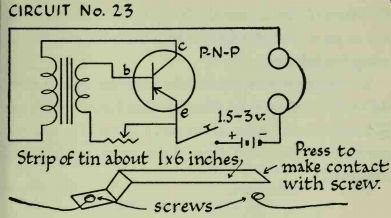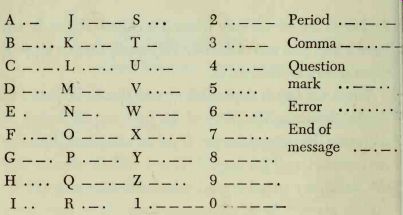Circuit No. 23: Code Practice Oscillator---parts needed:
doorbell, output or model - 1.5- to 3-volt power supply train; transformer headphones; transistor, any type telegraph key 500,000-ohm potentiometer
This is an audio oscillator. It is not a receiver, as it has no provisions for receiving, detecting, and amplifying a broadcast signal. Its sole purpose is to provide an audible tone in a pair of headphones or a loudspeaker.
Construct the circuit as shown. Almost any transistor can be used. The key acts as a switch, permitting current to flow in the circuit only when it is closed. If you do not have a key, you can make one very easily from a strip of sheet metal, as illustrated.
When the key is depressed, a tone should be heard in the headphones. The pitch of the tone can be varied by adjusting the potentiometer. If no tone is heard, turn the potentiometer all the way. If there is still no tone, reverse the secondary transformer leads; oscillation may not be taking place. Check all connections; there may be a break in the circuit.

-----------
Some output transformers will work only when they are connected in reverse. Hook up the primary leads where the secondary leads should be, and vice versa.
This oscillator will help you to become proficient in sending and receiving code. Radio amateurs use the Continental (International Morse) Code. You can practice in privacy at any time without disturbing anyone by using headphones. Its easy to learn to send code; receiving code is more difficult. If you hook up a loudspeaker instead of phones (through a transformer, of course), a group of people can practice at the same time. Take turns sending and receiving.
THE CONTINENTAL CODE

--------------

------------- HOW TO LEARN THE CODE
The best way to learn the cede is by thinking of each letter as a combination of sounds, rather than dots and dashes. Think of each dot as a dit, or short tone, and each dash as a dah, or longer tone. Here are the letters arranged in groups; learn one group before going on to the next: